Perceptual Distortion and Bias: Analysis and Solutions at CDU
VerifiedAdded on 2023/06/08
|9
|3011
|228
Essay
AI Summary
This essay delves into the complexities of perception, highlighting the various factors that contribute to perceptual distortion and bias. It begins by defining perception and perceptual distortion, emphasizing how individuals' interpretations of the world can differ significantly from reality. The essay then explores the perceptual process, outlining the key steps involved, including stimuli, selection, gap-filling, and proximity. It identifies several causes of perceptual distortion, such as stereotypes, the halo effect, selective perception, the contrast effect, projection, and the self-fulfilling prophecy. Furthermore, the essay discusses strategies for managing perceptual distortion, including authentic communication, empathy, fostering a positive attitude, understanding cultural influences, and avoiding rash judgments. The essay concludes by stressing the importance of addressing perceptual distortion in both personal and professional life to enhance understanding, improve communication, and increase organizational effectiveness. This student-contributed assignment is available on Desklib, a platform offering a wealth of academic resources for students.
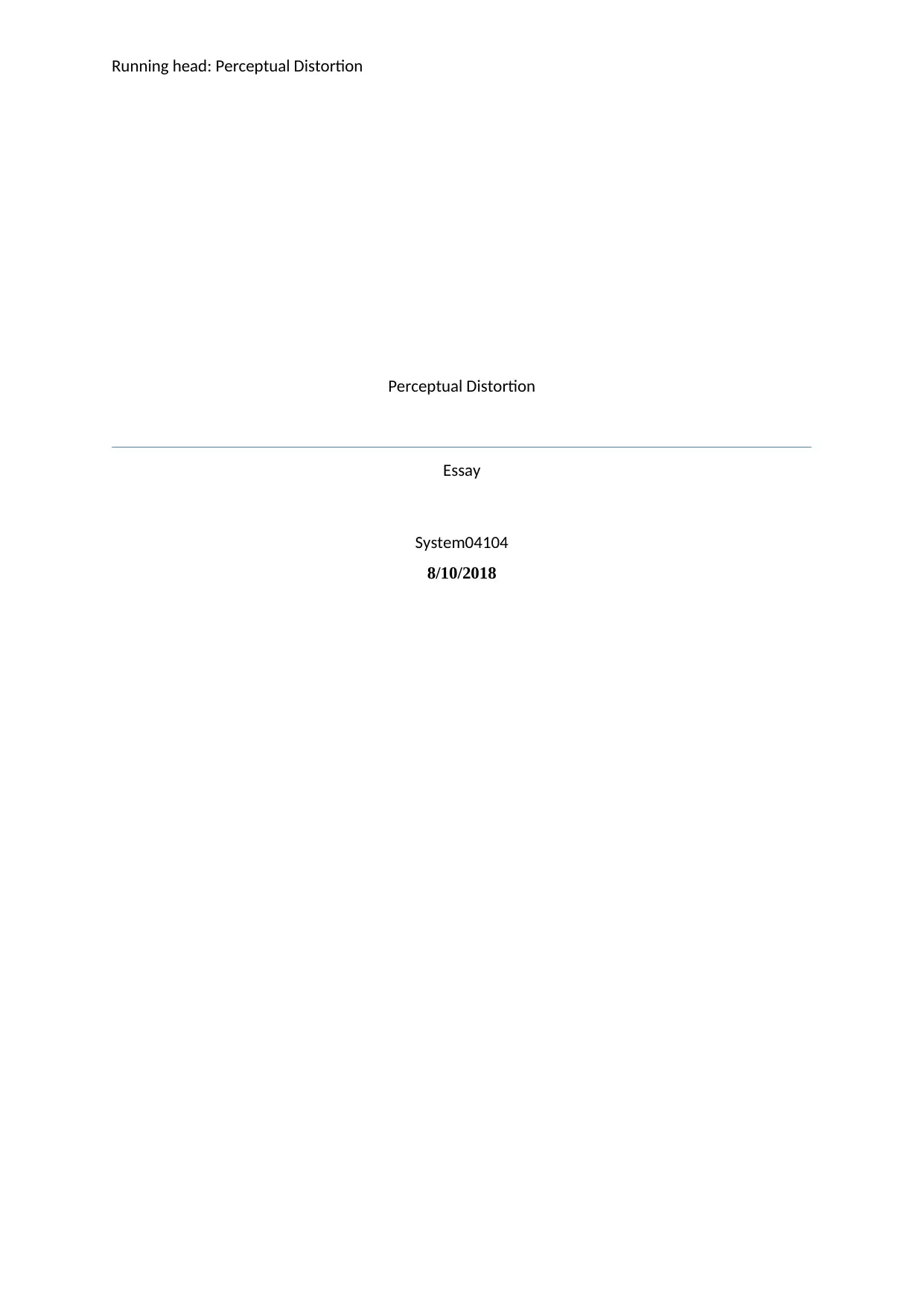
Running head: Perceptual Distortion
Perceptual Distortion
Essay
System04104
8/10/2018
Perceptual Distortion
Essay
System04104
8/10/2018
Paraphrase This Document
Need a fresh take? Get an instant paraphrase of this document with our AI Paraphraser
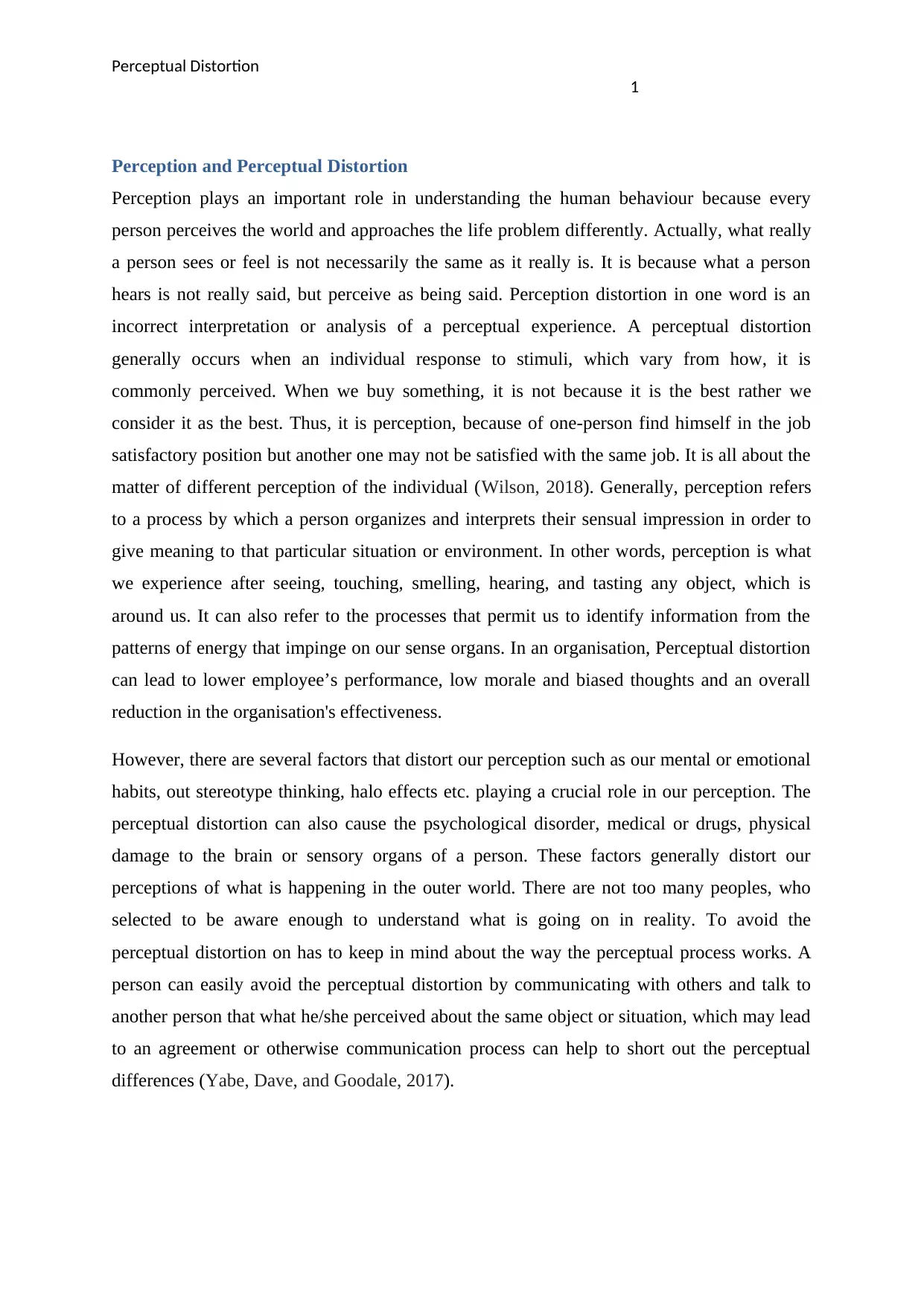
Perceptual Distortion
1
Perception and Perceptual Distortion
Perception plays an important role in understanding the human behaviour because every
person perceives the world and approaches the life problem differently. Actually, what really
a person sees or feel is not necessarily the same as it really is. It is because what a person
hears is not really said, but perceive as being said. Perception distortion in one word is an
incorrect interpretation or analysis of a perceptual experience. A perceptual distortion
generally occurs when an individual response to stimuli, which vary from how, it is
commonly perceived. When we buy something, it is not because it is the best rather we
consider it as the best. Thus, it is perception, because of one-person find himself in the job
satisfactory position but another one may not be satisfied with the same job. It is all about the
matter of different perception of the individual (Wilson, 2018). Generally, perception refers
to a process by which a person organizes and interprets their sensual impression in order to
give meaning to that particular situation or environment. In other words, perception is what
we experience after seeing, touching, smelling, hearing, and tasting any object, which is
around us. It can also refer to the processes that permit us to identify information from the
patterns of energy that impinge on our sense organs. In an organisation, Perceptual distortion
can lead to lower employee’s performance, low morale and biased thoughts and an overall
reduction in the organisation's effectiveness.
However, there are several factors that distort our perception such as our mental or emotional
habits, out stereotype thinking, halo effects etc. playing a crucial role in our perception. The
perceptual distortion can also cause the psychological disorder, medical or drugs, physical
damage to the brain or sensory organs of a person. These factors generally distort our
perceptions of what is happening in the outer world. There are not too many peoples, who
selected to be aware enough to understand what is going on in reality. To avoid the
perceptual distortion on has to keep in mind about the way the perceptual process works. A
person can easily avoid the perceptual distortion by communicating with others and talk to
another person that what he/she perceived about the same object or situation, which may lead
to an agreement or otherwise communication process can help to short out the perceptual
differences (Yabe, Dave, and Goodale, 2017).
1
Perception and Perceptual Distortion
Perception plays an important role in understanding the human behaviour because every
person perceives the world and approaches the life problem differently. Actually, what really
a person sees or feel is not necessarily the same as it really is. It is because what a person
hears is not really said, but perceive as being said. Perception distortion in one word is an
incorrect interpretation or analysis of a perceptual experience. A perceptual distortion
generally occurs when an individual response to stimuli, which vary from how, it is
commonly perceived. When we buy something, it is not because it is the best rather we
consider it as the best. Thus, it is perception, because of one-person find himself in the job
satisfactory position but another one may not be satisfied with the same job. It is all about the
matter of different perception of the individual (Wilson, 2018). Generally, perception refers
to a process by which a person organizes and interprets their sensual impression in order to
give meaning to that particular situation or environment. In other words, perception is what
we experience after seeing, touching, smelling, hearing, and tasting any object, which is
around us. It can also refer to the processes that permit us to identify information from the
patterns of energy that impinge on our sense organs. In an organisation, Perceptual distortion
can lead to lower employee’s performance, low morale and biased thoughts and an overall
reduction in the organisation's effectiveness.
However, there are several factors that distort our perception such as our mental or emotional
habits, out stereotype thinking, halo effects etc. playing a crucial role in our perception. The
perceptual distortion can also cause the psychological disorder, medical or drugs, physical
damage to the brain or sensory organs of a person. These factors generally distort our
perceptions of what is happening in the outer world. There are not too many peoples, who
selected to be aware enough to understand what is going on in reality. To avoid the
perceptual distortion on has to keep in mind about the way the perceptual process works. A
person can easily avoid the perceptual distortion by communicating with others and talk to
another person that what he/she perceived about the same object or situation, which may lead
to an agreement or otherwise communication process can help to short out the perceptual
differences (Yabe, Dave, and Goodale, 2017).
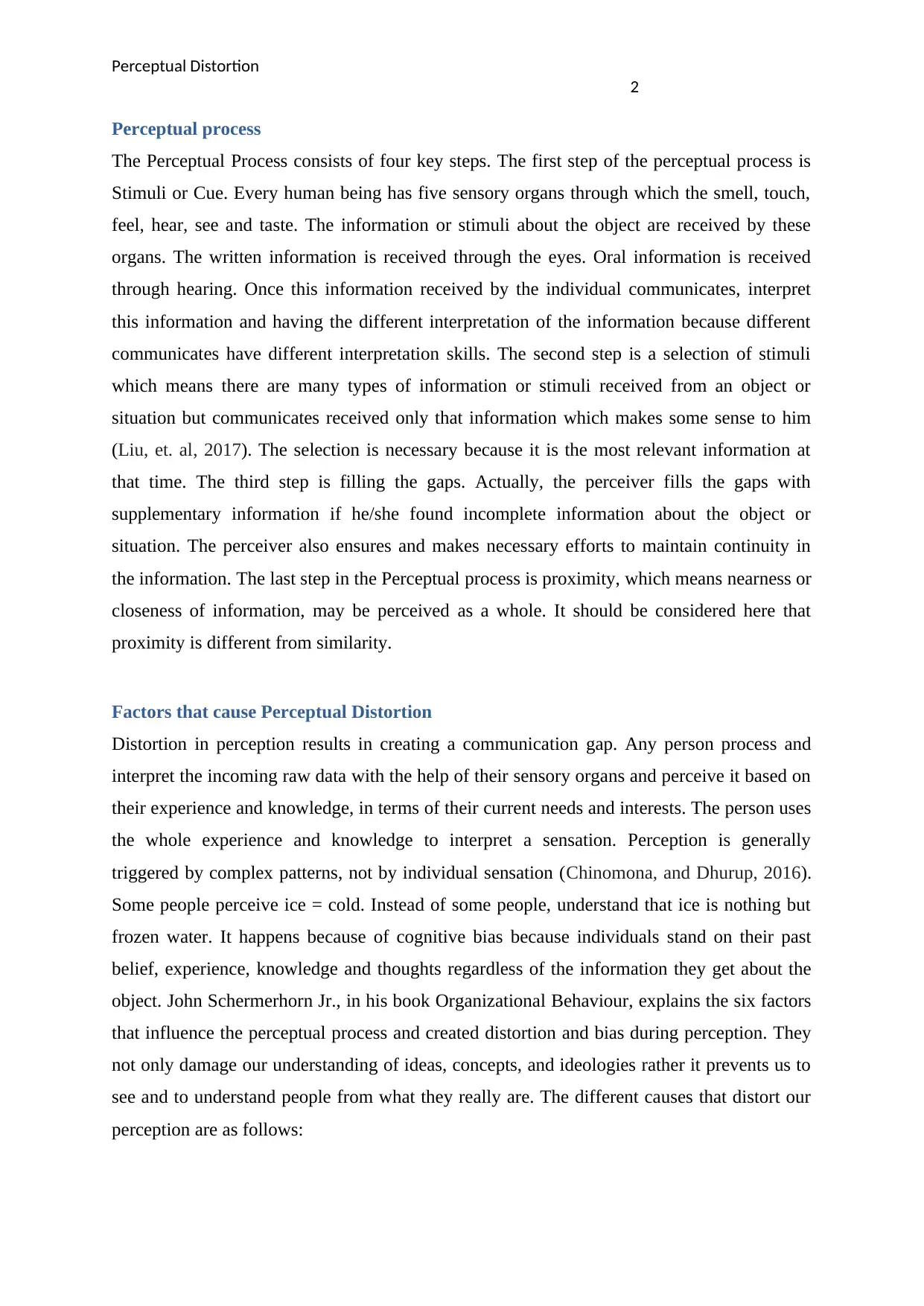
Perceptual Distortion
2
Perceptual process
The Perceptual Process consists of four key steps. The first step of the perceptual process is
Stimuli or Cue. Every human being has five sensory organs through which the smell, touch,
feel, hear, see and taste. The information or stimuli about the object are received by these
organs. The written information is received through the eyes. Oral information is received
through hearing. Once this information received by the individual communicates, interpret
this information and having the different interpretation of the information because different
communicates have different interpretation skills. The second step is a selection of stimuli
which means there are many types of information or stimuli received from an object or
situation but communicates received only that information which makes some sense to him
(Liu, et. al, 2017). The selection is necessary because it is the most relevant information at
that time. The third step is filling the gaps. Actually, the perceiver fills the gaps with
supplementary information if he/she found incomplete information about the object or
situation. The perceiver also ensures and makes necessary efforts to maintain continuity in
the information. The last step in the Perceptual process is proximity, which means nearness or
closeness of information, may be perceived as a whole. It should be considered here that
proximity is different from similarity.
Factors that cause Perceptual Distortion
Distortion in perception results in creating a communication gap. Any person process and
interpret the incoming raw data with the help of their sensory organs and perceive it based on
their experience and knowledge, in terms of their current needs and interests. The person uses
the whole experience and knowledge to interpret a sensation. Perception is generally
triggered by complex patterns, not by individual sensation (Chinomona, and Dhurup, 2016).
Some people perceive ice = cold. Instead of some people, understand that ice is nothing but
frozen water. It happens because of cognitive bias because individuals stand on their past
belief, experience, knowledge and thoughts regardless of the information they get about the
object. John Schermerhorn Jr., in his book Organizational Behaviour, explains the six factors
that influence the perceptual process and created distortion and bias during perception. They
not only damage our understanding of ideas, concepts, and ideologies rather it prevents us to
see and to understand people from what they really are. The different causes that distort our
perception are as follows:
2
Perceptual process
The Perceptual Process consists of four key steps. The first step of the perceptual process is
Stimuli or Cue. Every human being has five sensory organs through which the smell, touch,
feel, hear, see and taste. The information or stimuli about the object are received by these
organs. The written information is received through the eyes. Oral information is received
through hearing. Once this information received by the individual communicates, interpret
this information and having the different interpretation of the information because different
communicates have different interpretation skills. The second step is a selection of stimuli
which means there are many types of information or stimuli received from an object or
situation but communicates received only that information which makes some sense to him
(Liu, et. al, 2017). The selection is necessary because it is the most relevant information at
that time. The third step is filling the gaps. Actually, the perceiver fills the gaps with
supplementary information if he/she found incomplete information about the object or
situation. The perceiver also ensures and makes necessary efforts to maintain continuity in
the information. The last step in the Perceptual process is proximity, which means nearness or
closeness of information, may be perceived as a whole. It should be considered here that
proximity is different from similarity.
Factors that cause Perceptual Distortion
Distortion in perception results in creating a communication gap. Any person process and
interpret the incoming raw data with the help of their sensory organs and perceive it based on
their experience and knowledge, in terms of their current needs and interests. The person uses
the whole experience and knowledge to interpret a sensation. Perception is generally
triggered by complex patterns, not by individual sensation (Chinomona, and Dhurup, 2016).
Some people perceive ice = cold. Instead of some people, understand that ice is nothing but
frozen water. It happens because of cognitive bias because individuals stand on their past
belief, experience, knowledge and thoughts regardless of the information they get about the
object. John Schermerhorn Jr., in his book Organizational Behaviour, explains the six factors
that influence the perceptual process and created distortion and bias during perception. They
not only damage our understanding of ideas, concepts, and ideologies rather it prevents us to
see and to understand people from what they really are. The different causes that distort our
perception are as follows:
⊘ This is a preview!⊘
Do you want full access?
Subscribe today to unlock all pages.

Trusted by 1+ million students worldwide
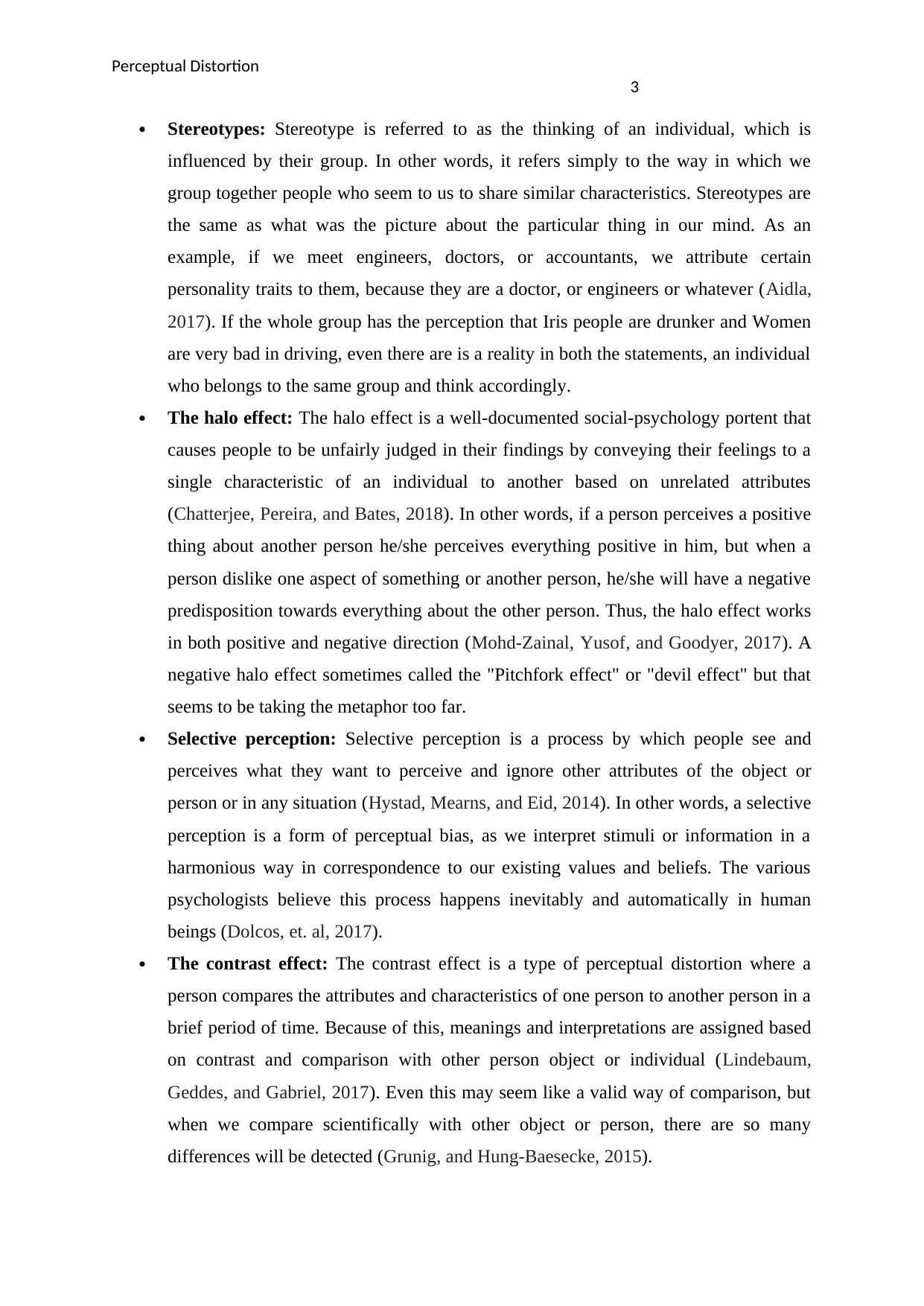
Perceptual Distortion
3
Stereotypes: Stereotype is referred to as the thinking of an individual, which is
influenced by their group. In other words, it refers simply to the way in which we
group together people who seem to us to share similar characteristics. Stereotypes are
the same as what was the picture about the particular thing in our mind. As an
example, if we meet engineers, doctors, or accountants, we attribute certain
personality traits to them, because they are a doctor, or engineers or whatever (Aidla,
2017). If the whole group has the perception that Iris people are drunker and Women
are very bad in driving, even there are is a reality in both the statements, an individual
who belongs to the same group and think accordingly.
The halo effect: The halo effect is a well-documented social-psychology portent that
causes people to be unfairly judged in their findings by conveying their feelings to a
single characteristic of an individual to another based on unrelated attributes
(Chatterjee, Pereira, and Bates, 2018). In other words, if a person perceives a positive
thing about another person he/she perceives everything positive in him, but when a
person dislike one aspect of something or another person, he/she will have a negative
predisposition towards everything about the other person. Thus, the halo effect works
in both positive and negative direction (Mohd-Zainal, Yusof, and Goodyer, 2017). A
negative halo effect sometimes called the "Pitchfork effect" or "devil effect" but that
seems to be taking the metaphor too far.
Selective perception: Selective perception is a process by which people see and
perceives what they want to perceive and ignore other attributes of the object or
person or in any situation (Hystad, Mearns, and Eid, 2014). In other words, a selective
perception is a form of perceptual bias, as we interpret stimuli or information in a
harmonious way in correspondence to our existing values and beliefs. The various
psychologists believe this process happens inevitably and automatically in human
beings (Dolcos, et. al, 2017).
The contrast effect: The contrast effect is a type of perceptual distortion where a
person compares the attributes and characteristics of one person to another person in a
brief period of time. Because of this, meanings and interpretations are assigned based
on contrast and comparison with other person object or individual (Lindebaum,
Geddes, and Gabriel, 2017). Even this may seem like a valid way of comparison, but
when we compare scientifically with other object or person, there are so many
differences will be detected (Grunig, and Hung-Baesecke, 2015).
3
Stereotypes: Stereotype is referred to as the thinking of an individual, which is
influenced by their group. In other words, it refers simply to the way in which we
group together people who seem to us to share similar characteristics. Stereotypes are
the same as what was the picture about the particular thing in our mind. As an
example, if we meet engineers, doctors, or accountants, we attribute certain
personality traits to them, because they are a doctor, or engineers or whatever (Aidla,
2017). If the whole group has the perception that Iris people are drunker and Women
are very bad in driving, even there are is a reality in both the statements, an individual
who belongs to the same group and think accordingly.
The halo effect: The halo effect is a well-documented social-psychology portent that
causes people to be unfairly judged in their findings by conveying their feelings to a
single characteristic of an individual to another based on unrelated attributes
(Chatterjee, Pereira, and Bates, 2018). In other words, if a person perceives a positive
thing about another person he/she perceives everything positive in him, but when a
person dislike one aspect of something or another person, he/she will have a negative
predisposition towards everything about the other person. Thus, the halo effect works
in both positive and negative direction (Mohd-Zainal, Yusof, and Goodyer, 2017). A
negative halo effect sometimes called the "Pitchfork effect" or "devil effect" but that
seems to be taking the metaphor too far.
Selective perception: Selective perception is a process by which people see and
perceives what they want to perceive and ignore other attributes of the object or
person or in any situation (Hystad, Mearns, and Eid, 2014). In other words, a selective
perception is a form of perceptual bias, as we interpret stimuli or information in a
harmonious way in correspondence to our existing values and beliefs. The various
psychologists believe this process happens inevitably and automatically in human
beings (Dolcos, et. al, 2017).
The contrast effect: The contrast effect is a type of perceptual distortion where a
person compares the attributes and characteristics of one person to another person in a
brief period of time. Because of this, meanings and interpretations are assigned based
on contrast and comparison with other person object or individual (Lindebaum,
Geddes, and Gabriel, 2017). Even this may seem like a valid way of comparison, but
when we compare scientifically with other object or person, there are so many
differences will be detected (Grunig, and Hung-Baesecke, 2015).
Paraphrase This Document
Need a fresh take? Get an instant paraphrase of this document with our AI Paraphraser
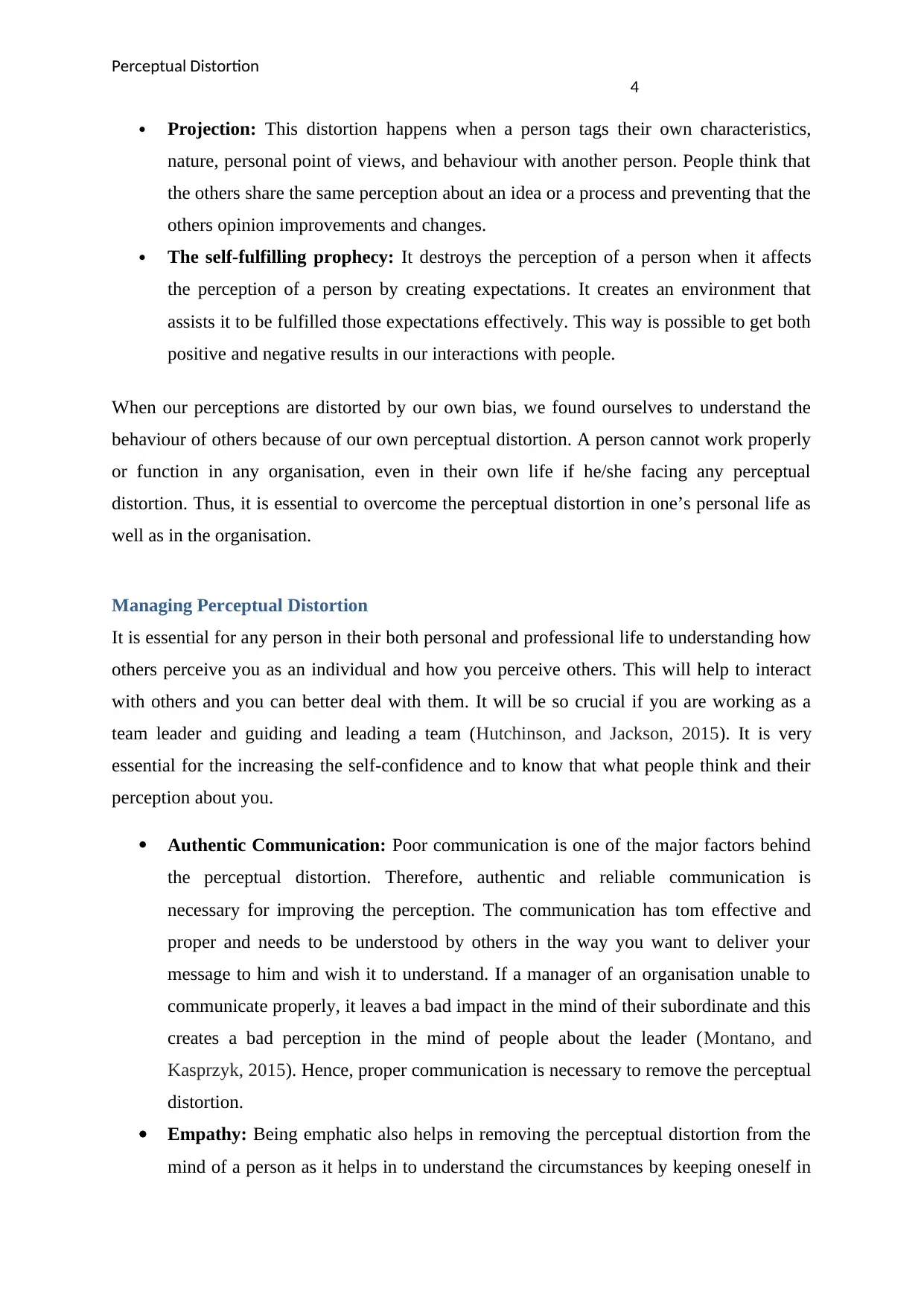
Perceptual Distortion
4
Projection: This distortion happens when a person tags their own characteristics,
nature, personal point of views, and behaviour with another person. People think that
the others share the same perception about an idea or a process and preventing that the
others opinion improvements and changes.
The self-fulfilling prophecy: It destroys the perception of a person when it affects
the perception of a person by creating expectations. It creates an environment that
assists it to be fulfilled those expectations effectively. This way is possible to get both
positive and negative results in our interactions with people.
When our perceptions are distorted by our own bias, we found ourselves to understand the
behaviour of others because of our own perceptual distortion. A person cannot work properly
or function in any organisation, even in their own life if he/she facing any perceptual
distortion. Thus, it is essential to overcome the perceptual distortion in one’s personal life as
well as in the organisation.
Managing Perceptual Distortion
It is essential for any person in their both personal and professional life to understanding how
others perceive you as an individual and how you perceive others. This will help to interact
with others and you can better deal with them. It will be so crucial if you are working as a
team leader and guiding and leading a team (Hutchinson, and Jackson, 2015). It is very
essential for the increasing the self-confidence and to know that what people think and their
perception about you.
Authentic Communication: Poor communication is one of the major factors behind
the perceptual distortion. Therefore, authentic and reliable communication is
necessary for improving the perception. The communication has tom effective and
proper and needs to be understood by others in the way you want to deliver your
message to him and wish it to understand. If a manager of an organisation unable to
communicate properly, it leaves a bad impact in the mind of their subordinate and this
creates a bad perception in the mind of people about the leader (Montano, and
Kasprzyk, 2015). Hence, proper communication is necessary to remove the perceptual
distortion.
Empathy: Being emphatic also helps in removing the perceptual distortion from the
mind of a person as it helps in to understand the circumstances by keeping oneself in
4
Projection: This distortion happens when a person tags their own characteristics,
nature, personal point of views, and behaviour with another person. People think that
the others share the same perception about an idea or a process and preventing that the
others opinion improvements and changes.
The self-fulfilling prophecy: It destroys the perception of a person when it affects
the perception of a person by creating expectations. It creates an environment that
assists it to be fulfilled those expectations effectively. This way is possible to get both
positive and negative results in our interactions with people.
When our perceptions are distorted by our own bias, we found ourselves to understand the
behaviour of others because of our own perceptual distortion. A person cannot work properly
or function in any organisation, even in their own life if he/she facing any perceptual
distortion. Thus, it is essential to overcome the perceptual distortion in one’s personal life as
well as in the organisation.
Managing Perceptual Distortion
It is essential for any person in their both personal and professional life to understanding how
others perceive you as an individual and how you perceive others. This will help to interact
with others and you can better deal with them. It will be so crucial if you are working as a
team leader and guiding and leading a team (Hutchinson, and Jackson, 2015). It is very
essential for the increasing the self-confidence and to know that what people think and their
perception about you.
Authentic Communication: Poor communication is one of the major factors behind
the perceptual distortion. Therefore, authentic and reliable communication is
necessary for improving the perception. The communication has tom effective and
proper and needs to be understood by others in the way you want to deliver your
message to him and wish it to understand. If a manager of an organisation unable to
communicate properly, it leaves a bad impact in the mind of their subordinate and this
creates a bad perception in the mind of people about the leader (Montano, and
Kasprzyk, 2015). Hence, proper communication is necessary to remove the perceptual
distortion.
Empathy: Being emphatic also helps in removing the perceptual distortion from the
mind of a person as it helps in to understand the circumstances by keeping oneself in
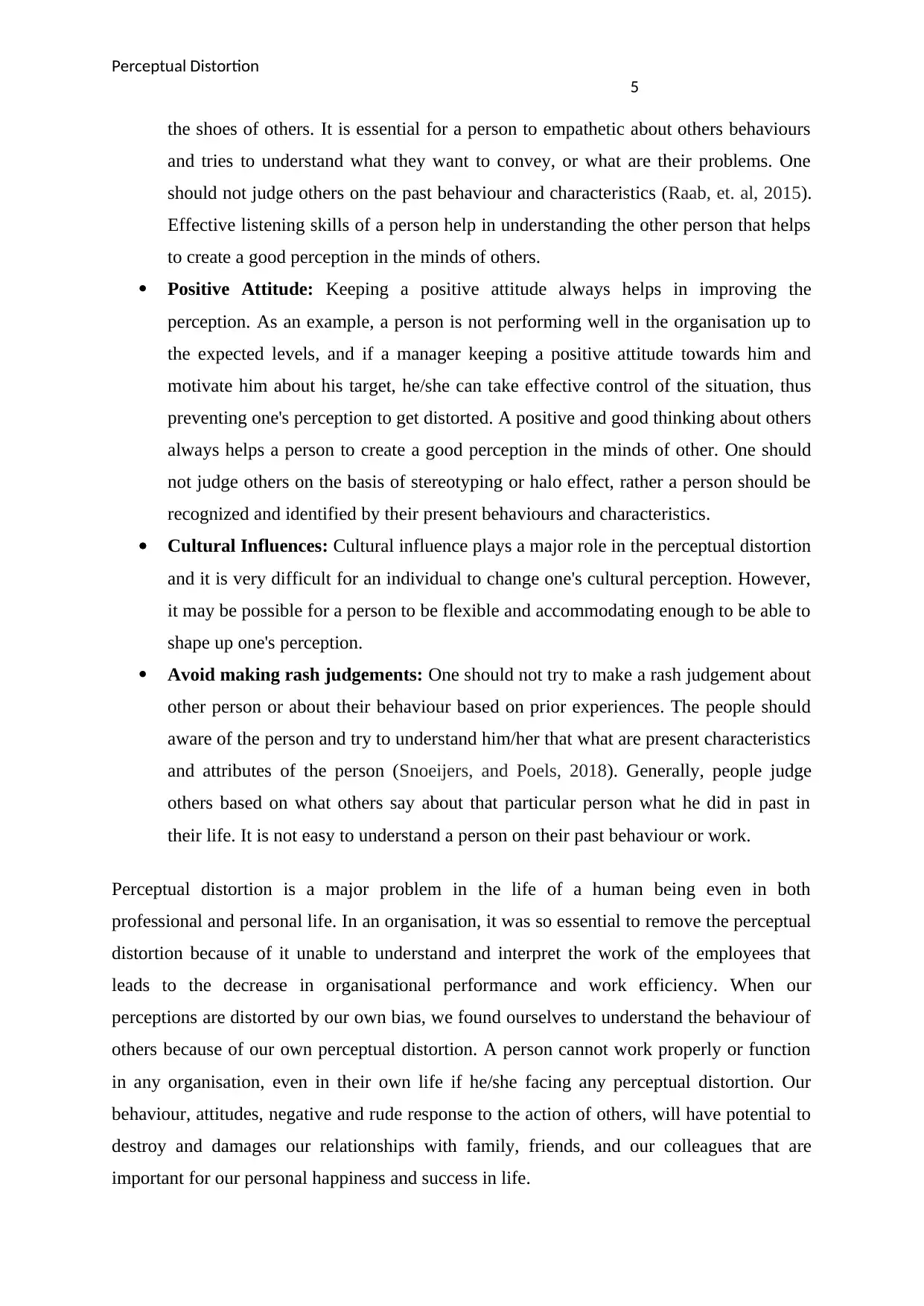
Perceptual Distortion
5
the shoes of others. It is essential for a person to empathetic about others behaviours
and tries to understand what they want to convey, or what are their problems. One
should not judge others on the past behaviour and characteristics (Raab, et. al, 2015).
Effective listening skills of a person help in understanding the other person that helps
to create a good perception in the minds of others.
Positive Attitude: Keeping a positive attitude always helps in improving the
perception. As an example, a person is not performing well in the organisation up to
the expected levels, and if a manager keeping a positive attitude towards him and
motivate him about his target, he/she can take effective control of the situation, thus
preventing one's perception to get distorted. A positive and good thinking about others
always helps a person to create a good perception in the minds of other. One should
not judge others on the basis of stereotyping or halo effect, rather a person should be
recognized and identified by their present behaviours and characteristics.
Cultural Influences: Cultural influence plays a major role in the perceptual distortion
and it is very difficult for an individual to change one's cultural perception. However,
it may be possible for a person to be flexible and accommodating enough to be able to
shape up one's perception.
Avoid making rash judgements: One should not try to make a rash judgement about
other person or about their behaviour based on prior experiences. The people should
aware of the person and try to understand him/her that what are present characteristics
and attributes of the person (Snoeijers, and Poels, 2018). Generally, people judge
others based on what others say about that particular person what he did in past in
their life. It is not easy to understand a person on their past behaviour or work.
Perceptual distortion is a major problem in the life of a human being even in both
professional and personal life. In an organisation, it was so essential to remove the perceptual
distortion because of it unable to understand and interpret the work of the employees that
leads to the decrease in organisational performance and work efficiency. When our
perceptions are distorted by our own bias, we found ourselves to understand the behaviour of
others because of our own perceptual distortion. A person cannot work properly or function
in any organisation, even in their own life if he/she facing any perceptual distortion. Our
behaviour, attitudes, negative and rude response to the action of others, will have potential to
destroy and damages our relationships with family, friends, and our colleagues that are
important for our personal happiness and success in life.
5
the shoes of others. It is essential for a person to empathetic about others behaviours
and tries to understand what they want to convey, or what are their problems. One
should not judge others on the past behaviour and characteristics (Raab, et. al, 2015).
Effective listening skills of a person help in understanding the other person that helps
to create a good perception in the minds of others.
Positive Attitude: Keeping a positive attitude always helps in improving the
perception. As an example, a person is not performing well in the organisation up to
the expected levels, and if a manager keeping a positive attitude towards him and
motivate him about his target, he/she can take effective control of the situation, thus
preventing one's perception to get distorted. A positive and good thinking about others
always helps a person to create a good perception in the minds of other. One should
not judge others on the basis of stereotyping or halo effect, rather a person should be
recognized and identified by their present behaviours and characteristics.
Cultural Influences: Cultural influence plays a major role in the perceptual distortion
and it is very difficult for an individual to change one's cultural perception. However,
it may be possible for a person to be flexible and accommodating enough to be able to
shape up one's perception.
Avoid making rash judgements: One should not try to make a rash judgement about
other person or about their behaviour based on prior experiences. The people should
aware of the person and try to understand him/her that what are present characteristics
and attributes of the person (Snoeijers, and Poels, 2018). Generally, people judge
others based on what others say about that particular person what he did in past in
their life. It is not easy to understand a person on their past behaviour or work.
Perceptual distortion is a major problem in the life of a human being even in both
professional and personal life. In an organisation, it was so essential to remove the perceptual
distortion because of it unable to understand and interpret the work of the employees that
leads to the decrease in organisational performance and work efficiency. When our
perceptions are distorted by our own bias, we found ourselves to understand the behaviour of
others because of our own perceptual distortion. A person cannot work properly or function
in any organisation, even in their own life if he/she facing any perceptual distortion. Our
behaviour, attitudes, negative and rude response to the action of others, will have potential to
destroy and damages our relationships with family, friends, and our colleagues that are
important for our personal happiness and success in life.
⊘ This is a preview!⊘
Do you want full access?
Subscribe today to unlock all pages.

Trusted by 1+ million students worldwide

Perceptual Distortion
6
6
Paraphrase This Document
Need a fresh take? Get an instant paraphrase of this document with our AI Paraphraser
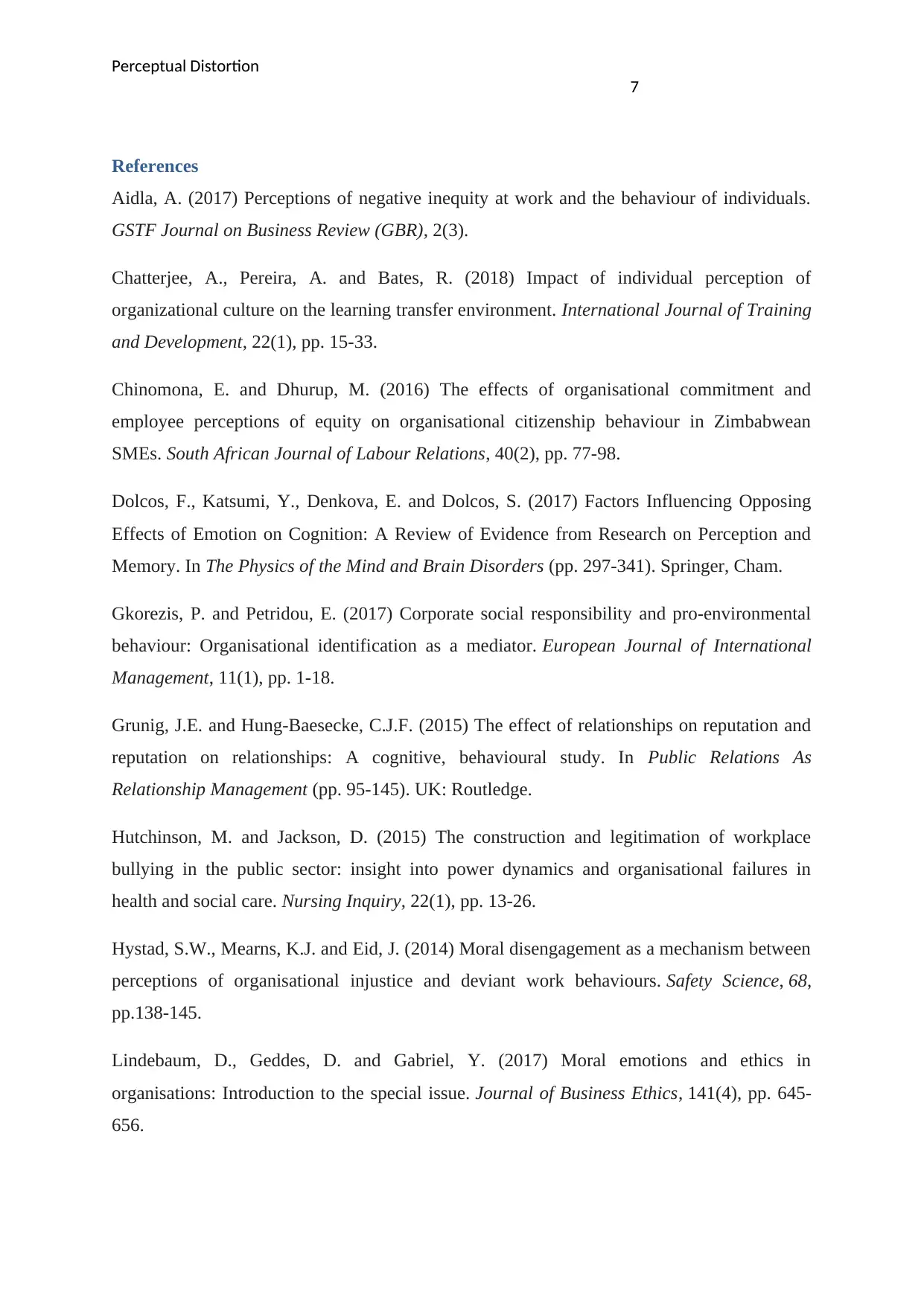
Perceptual Distortion
7
References
Aidla, A. (2017) Perceptions of negative inequity at work and the behaviour of individuals.
GSTF Journal on Business Review (GBR), 2(3).
Chatterjee, A., Pereira, A. and Bates, R. (2018) Impact of individual perception of
organizational culture on the learning transfer environment. International Journal of Training
and Development, 22(1), pp. 15-33.
Chinomona, E. and Dhurup, M. (2016) The effects of organisational commitment and
employee perceptions of equity on organisational citizenship behaviour in Zimbabwean
SMEs. South African Journal of Labour Relations, 40(2), pp. 77-98.
Dolcos, F., Katsumi, Y., Denkova, E. and Dolcos, S. (2017) Factors Influencing Opposing
Effects of Emotion on Cognition: A Review of Evidence from Research on Perception and
Memory. In The Physics of the Mind and Brain Disorders (pp. 297-341). Springer, Cham.
Gkorezis, P. and Petridou, E. (2017) Corporate social responsibility and pro-environmental
behaviour: Organisational identification as a mediator. European Journal of International
Management, 11(1), pp. 1-18.
Grunig, J.E. and Hung-Baesecke, C.J.F. (2015) The effect of relationships on reputation and
reputation on relationships: A cognitive, behavioural study. In Public Relations As
Relationship Management (pp. 95-145). UK: Routledge.
Hutchinson, M. and Jackson, D. (2015) The construction and legitimation of workplace
bullying in the public sector: insight into power dynamics and organisational failures in
health and social care. Nursing Inquiry, 22(1), pp. 13-26.
Hystad, S.W., Mearns, K.J. and Eid, J. (2014) Moral disengagement as a mechanism between
perceptions of organisational injustice and deviant work behaviours. Safety Science, 68,
pp.138-145.
Lindebaum, D., Geddes, D. and Gabriel, Y. (2017) Moral emotions and ethics in
organisations: Introduction to the special issue. Journal of Business Ethics, 141(4), pp. 645-
656.
7
References
Aidla, A. (2017) Perceptions of negative inequity at work and the behaviour of individuals.
GSTF Journal on Business Review (GBR), 2(3).
Chatterjee, A., Pereira, A. and Bates, R. (2018) Impact of individual perception of
organizational culture on the learning transfer environment. International Journal of Training
and Development, 22(1), pp. 15-33.
Chinomona, E. and Dhurup, M. (2016) The effects of organisational commitment and
employee perceptions of equity on organisational citizenship behaviour in Zimbabwean
SMEs. South African Journal of Labour Relations, 40(2), pp. 77-98.
Dolcos, F., Katsumi, Y., Denkova, E. and Dolcos, S. (2017) Factors Influencing Opposing
Effects of Emotion on Cognition: A Review of Evidence from Research on Perception and
Memory. In The Physics of the Mind and Brain Disorders (pp. 297-341). Springer, Cham.
Gkorezis, P. and Petridou, E. (2017) Corporate social responsibility and pro-environmental
behaviour: Organisational identification as a mediator. European Journal of International
Management, 11(1), pp. 1-18.
Grunig, J.E. and Hung-Baesecke, C.J.F. (2015) The effect of relationships on reputation and
reputation on relationships: A cognitive, behavioural study. In Public Relations As
Relationship Management (pp. 95-145). UK: Routledge.
Hutchinson, M. and Jackson, D. (2015) The construction and legitimation of workplace
bullying in the public sector: insight into power dynamics and organisational failures in
health and social care. Nursing Inquiry, 22(1), pp. 13-26.
Hystad, S.W., Mearns, K.J. and Eid, J. (2014) Moral disengagement as a mechanism between
perceptions of organisational injustice and deviant work behaviours. Safety Science, 68,
pp.138-145.
Lindebaum, D., Geddes, D. and Gabriel, Y. (2017) Moral emotions and ethics in
organisations: Introduction to the special issue. Journal of Business Ethics, 141(4), pp. 645-
656.
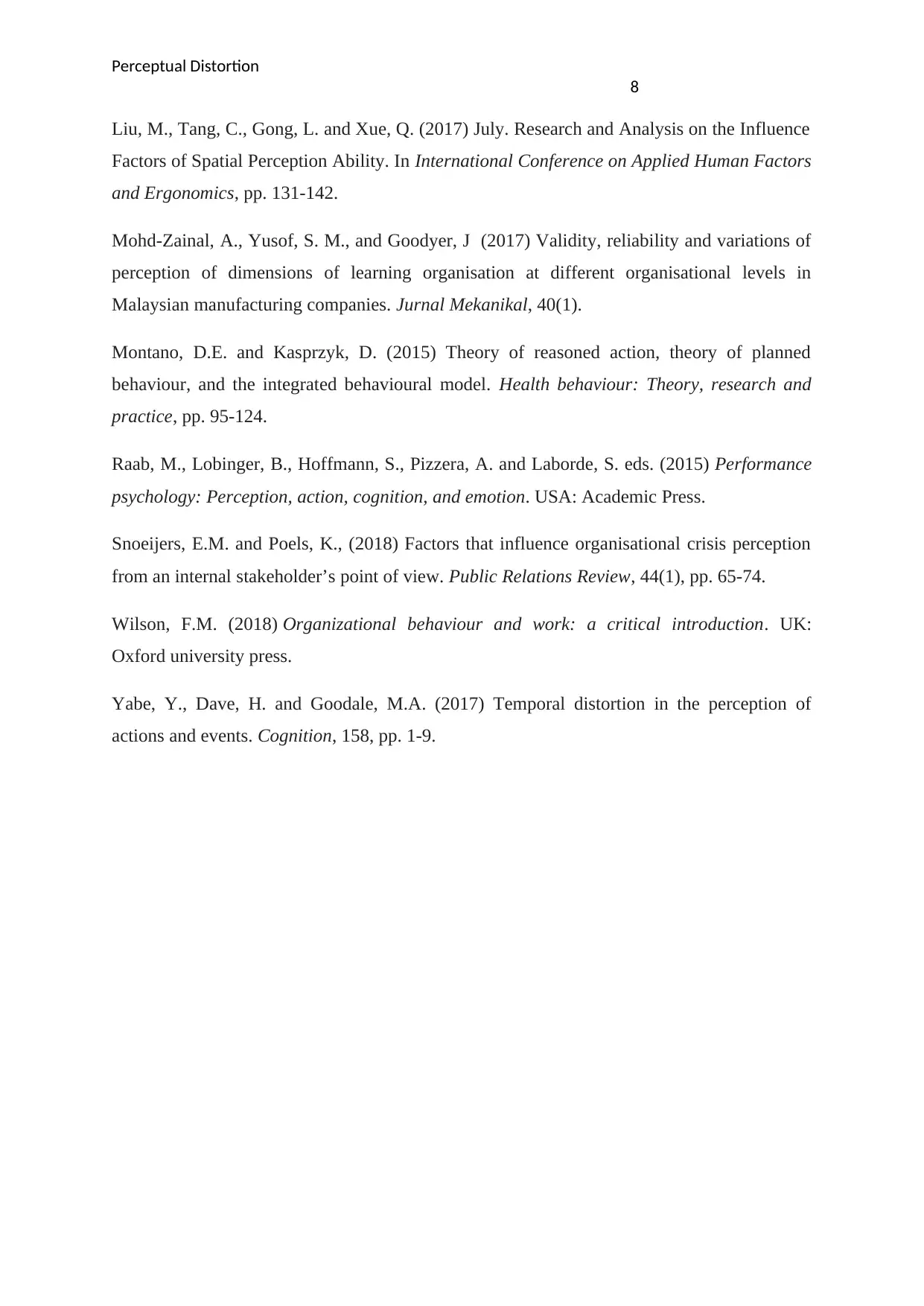
Perceptual Distortion
8
Liu, M., Tang, C., Gong, L. and Xue, Q. (2017) July. Research and Analysis on the Influence
Factors of Spatial Perception Ability. In International Conference on Applied Human Factors
and Ergonomics, pp. 131-142.
Mohd-Zainal, A., Yusof, S. M., and Goodyer, J (2017) Validity, reliability and variations of
perception of dimensions of learning organisation at different organisational levels in
Malaysian manufacturing companies. Jurnal Mekanikal, 40(1).
Montano, D.E. and Kasprzyk, D. (2015) Theory of reasoned action, theory of planned
behaviour, and the integrated behavioural model. Health behaviour: Theory, research and
practice, pp. 95-124.
Raab, M., Lobinger, B., Hoffmann, S., Pizzera, A. and Laborde, S. eds. (2015) Performance
psychology: Perception, action, cognition, and emotion. USA: Academic Press.
Snoeijers, E.M. and Poels, K., (2018) Factors that influence organisational crisis perception
from an internal stakeholder’s point of view. Public Relations Review, 44(1), pp. 65-74.
Wilson, F.M. (2018) Organizational behaviour and work: a critical introduction. UK:
Oxford university press.
Yabe, Y., Dave, H. and Goodale, M.A. (2017) Temporal distortion in the perception of
actions and events. Cognition, 158, pp. 1-9.
8
Liu, M., Tang, C., Gong, L. and Xue, Q. (2017) July. Research and Analysis on the Influence
Factors of Spatial Perception Ability. In International Conference on Applied Human Factors
and Ergonomics, pp. 131-142.
Mohd-Zainal, A., Yusof, S. M., and Goodyer, J (2017) Validity, reliability and variations of
perception of dimensions of learning organisation at different organisational levels in
Malaysian manufacturing companies. Jurnal Mekanikal, 40(1).
Montano, D.E. and Kasprzyk, D. (2015) Theory of reasoned action, theory of planned
behaviour, and the integrated behavioural model. Health behaviour: Theory, research and
practice, pp. 95-124.
Raab, M., Lobinger, B., Hoffmann, S., Pizzera, A. and Laborde, S. eds. (2015) Performance
psychology: Perception, action, cognition, and emotion. USA: Academic Press.
Snoeijers, E.M. and Poels, K., (2018) Factors that influence organisational crisis perception
from an internal stakeholder’s point of view. Public Relations Review, 44(1), pp. 65-74.
Wilson, F.M. (2018) Organizational behaviour and work: a critical introduction. UK:
Oxford university press.
Yabe, Y., Dave, H. and Goodale, M.A. (2017) Temporal distortion in the perception of
actions and events. Cognition, 158, pp. 1-9.
⊘ This is a preview!⊘
Do you want full access?
Subscribe today to unlock all pages.

Trusted by 1+ million students worldwide
1 out of 9
Related Documents
Your All-in-One AI-Powered Toolkit for Academic Success.
+13062052269
info@desklib.com
Available 24*7 on WhatsApp / Email
![[object Object]](/_next/static/media/star-bottom.7253800d.svg)
Unlock your academic potential
Copyright © 2020–2025 A2Z Services. All Rights Reserved. Developed and managed by ZUCOL.





